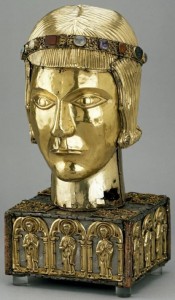Pilgrim Tales – summer storytelling at The British Museum
When did we stop believing? For medieval pilgrims the sight of a splinter of wood, a drop of blood, a fragment of bone, a scrap of textile, or a phial of tears, would cause rapture, weeping, and prayer. Dust would be scraped from the tombs of saints and drunk as a magical potion. Oil or water would miraculously appear on a relic, and pilgrims would dip their handkerchiefs into the substance, to bring healing power.
At my convent school I heard stories about fragments of Christ’s cross and the Virgin’s tears. I was not sure if these objects existed or were fairytales. And then, walking through the Treasures of Heaven exhibition, there they all were! Not one fragment of the cross, but several! Splinters visible behind crystal windows set in glittering caskets and crosses. Pilgrims would journey for weeks to see, kiss, and touch these holy objects. But we don’t believe in their power any more.

Then I remember the Temple of the Tooth in Sri Lanka. I joined crowds carrying flowers and candles, and surrounded by pounding drums, slowly processed past the Buddha’s tooth. I gazed at a gleaming casket buried in lotus blossoms and felt that I had received a blessing. Does it matter if the tooth is really the Buddha’s tooth? The relic has accrued power and meaning through hundreds of years of veneration. And the act of pilgrimage itself, is healing.
I will be exploring ideas of relics and pilgrimage in Pilgrim Tales – part of The British Museum’s family summer events linked to the Treasures of Heaven exhibition. You can join a dance, make a pilgrim badge, or listen to a medieval story.
Pilgrim Tales draws on medieval legends, Byzantine myths, and stories of the saints, to conjure monsters, miracles, and the search for the treasure of heaven.
Pilgrim Tales
for children and family audiences.
Performances in the Enlightenment Gallery (Room 1)
Thursday 28th July, Thursday 4th August, Thursday 11th August, Thursday 18 August, Thursday 25th August, Monday 29th August, 2011.
The performance is free, lasts 30 minutes, and is repeated:
12.00 – 12.30
1.00 – 1.30
2.00 – 2.30
3.00 – 3.30

Leave a Reply